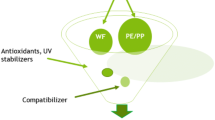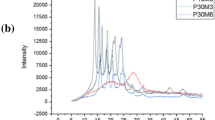Abstract
This work aimed to investigate the effects of wood waste types (twigs, leaves, and palm fronds) and contents (ranging from 40 to 60 wt%) on the physical and mechanical properties of plastic bag composites under sea coast climate conditions. Wood-plastic composite (WPC) pellets were blended with a twin screw extruder, and sample panels were compressed using a compression molding machine. Statistical analysis indicated that exposure time led to significantly deteriorating changes in all the physical and mechanical properties of WPCs. The lightness and total color change values altered with an increase in exposure time. An increase of wood waste content from 40 to 60 wt% in plastic bag composites increased the percentage loss for modulus of rupture (MOR), modulus of elasticity (MOE), screw withdrawal strength (SWS), and hardness, which is relative to micro-cracks on the surface of the WPCs. Overall, the mechanical properties of the plastic bag composites based on twigs had less loss and superior MOR, MOE, SWS, and hardness compared to those based on leaves and palm fronds, at equal plastic to wood ratios. Thus, plastic bag composites based on twigs are recommended for the manufacture of WPC materials in applications for construction and building products.









Similar content being viewed by others
References
Kamdar I, Ali S, Bennui A, Techato K, Jutidamrongphan W (2019) Municipal solid waste landfill siting using an integrated GIS-AHP approach: a case study from Songkhla. Thailand Resour Conserv Recyc 149:220–235
Markphan W, Mamimin C, Suksong W, Prasertsan P, O-Thong S (2020) Comparative assessment of single-stage and two-stage anaerobic digestion for biogas production from high moisture municipal solid waste. Peer J 10(7717):9693
PCD (2019) Thailand State of Pollution Control Report, 2019. Pollution Control Department, Ministry of Natural Resources and Environment (Thailand). http://infofile.pcd.go.th/Waste/Wst2019.pdf. Accessed 15 Apr 2021
Ashori A (2008) Municipal solid waste as a source of lignocellulosic fiber and plastic for composite industries. Polym Plast Technol Eng 47:741–744
McKeever DB, Younquist JA, English BW (1995) Sources and availability of recovered wood and fiber for composite products In: Proceedings of the 29th international particleboard composite materials symposium. Washington State University, Pullman, WA, pp 197–214
Carroll DR, Stone RB, Sirignano AM, Saindon RM, Gose SC, Friedman AM (2011) Structural properties of recycled plastic/sawdust lumber decking planks. Resour Conserv Recyc 31:241–251
Turku I, Keskisaari A, Kärki T, Puurtinen A, Marttila P (2017) Characterization of wood plastic composites manufactured from recycled plastic blends. Compos Struct 161:469–476
Sommerhuber PF, Welling J, Krause A (2015) Substitution potentials of recycled HDPE and wood particles from post-consumer packaging waste in wood–plastic composites. Waste Manag 46:76–85
Khanjanzadeh H, Tabarsa T, Shakeri A, Omidvar A (2011) Effect of organoclay platelets on the mechanical properties of wood–plastic composites formulated with virgin and recycled polypropylene. Wood Mater Sci Eng 6:207–212
Binhussain M, El-Tonsy M (2013) Palm leave and plastic waste wood composite for out-door structures. Constr Build Mater 47:1431–1435
Homkhiew C, Ratanawilai T, Thongruang W (2014) Effects of natural weathering on the properties of recycled polypropylene composites reinforced with rubberwood flour. Ind Crop Prod 56:52–59
Ratanawilai T, Taneerat K (2018) Alternative polymeric matrices for wood-plastic composites: effects on mechanical properties and resistance to natural weathering. Constr Build Mater 172:349–357
Yadav SKJ, Vedrtnam A, Gunwant D (2020) Experimental and numerical study on mechanical behavior and resistance to natural weathering of sugarcane leave reinforced polymer composite. Constr Build Mater 262:120785
Shanshan L, Liu X, Gu J, Jiang Y, Tan H, Zhang Y (2017) Effect of glycerol introduced into PLA based composites on the UV weathering behavior. Constr Build Mater 144:525–531
Friedrich D, Luible A (2016) Investigations on ageing of wood-plastic composites for outdoor applications: a meta-analysis using empiric data derived from diverse weathering trials. Constr Build Mater 124:1142–1152
Ratanawilai T, Nakawirot K, Deachsrijan A, Homkhiew C (2014) Influence of wood species and particle size on mechanical and thermal properties of wood polypropylene composites. Fiber Polym 15:2160–2168
Essabir H, Boujmal R, Bensalah MO, Rodrigue D, Bouhfid R, Qaiss A (2016) Mechanical and thermal properties of hybrid composites: oil-palm fiber/clay reinforced high density polyethylene. Mech Mater 98:36–43
Homkhiew C, Boonchouytan W, Cheewawuttipong W, Ratanawilai T (2018) Potential utilization of rubberwood flour and sludge waste from natural rubber manufacturing process as reinforcement in plastic composites. J Mater Cycles Waste Manag 20:1792–1803
Adhikary KB, Pang S, Staiger MP (2008) Long-term moisture absorption and thickness swelling behaviour of recycled thermoplastics reinforced with pinus radiate sawdust. Chem Eng J 142:190–198
Bouafif H, Koubaa A, Perré P, Cloutier A (2009) Effects of fiber characteristics on the physical and mechanical properties of wood plastic composites. Compos Part A 40:1975–1981
Hao XL, Yi X, Sun LC, Tu DY, Wang QW, Ou RX (2020) Mechanical properties, creep resistance, and dimensional stability of core/shell structured wood flour/polyethylene composites with highly filled core layer. Constr Build Mater 226:879–887
Vantsi O, Karki T (2015) Different coupling agents in wood-polypropylene composites containing recycled mineral wool: a comparison of the effects. J Reinf Plast Compos 34:879–895
Srivabut C, Ratanawilai T, Hiziroglu S (2018) Effect of nanoclay, talcum, and calcium carbonate as filler on properties of composites manufactured from recycled polypropylene and rubberwood fiber. Constr Build Mater 162:450–458
Khamtree S, Ratanawilai T, Ratanawilai S (2020) The effect of alkaline–silane treatment of rubberwood flour for water absorption and mechanical properties of plastic composites. J Thermoplast Compos Mater 33:599–613
Behzad K, Ali V, Vahid C (2016) Influence of chemical foaming agent on the physical, mechanical, and morphological properties of HDPE/wood flour/nanoclay composites. J Reinf Plast Compos 30:1115–1124
Svetlana B, Marko H, Timo K (2012) Accelerated weathering of wood-polypropylene composites containing minerals. Polym Degrad Stabil 97:337–345
Asim M, Jawaid M, Abdan K, Ishak MR (2016) Effect of alkaline and silane treatments on mechanical and fibre-matrix bond strength of kenaf and pineapple leaf fibres. J Bionic Eng 13:426–435
Valles R, Delia J, Mendez G, Luis C, Rodriguez P, Luis A (2016) Wood chile peppers stalks-plastic composite production. Maderas: Cienc Tecnol 18:179–190
Friedrich D (2019) Effects from natural weathering on long-term structural performance of wood-polymer composite cladding in the building envelope. J Build Engine 23:68–76
Chaharmahali M, Tajvidi M, Najafi SK (2008) Mechanical properties of wood plastic composite panels made from waste fiberboard and particleboard. Polym Compos 10:606–610
Pereira AAC, Almeida JRM (2018) Mechanical and physical screw withdrawal properties behavior of agglomerated panels reinforced with coir and pejibaye fibers. Wood Mater Sci Engine 13:286–295
Leng W, Hunt FJ, Tajvidi M (2017) Screw and nail withdrawal strength and water soak properties of wet-formed cellulose nanofibrils bonded particleboard. BioResources 12:7692–7710
Srivabut C, Ratanawilai T, Hiziroglu S (2021) Statistical modeling and response surface optimization on natural weathering of wood-plastic composites with calcium carbonate filler. J Mater Cycles Waste Manag 23:1503–1517
Mu Y, Chen AB, Zhao GQ, Cui YJ, Feng JJ, Ren FF (2018) Prediction for the mechanical property of short-reinforced polymer composites through process modeling method. J Thermoplast Compos Mater 32:1525–1546
Acknowledgements
The authors gratefully acknowledge the financial support from the Thailand Science Research and Innovation (Research Grant Code: 324) and the Rajamangala University of Technology Srivijaya (RMUTSV), Thailand. We would also like to thank Mr. Kittisak Sengseng and Mr. Kittisak Chokchulee for supporting this work.
Author information
Authors and Affiliations
Corresponding author
Additional information
Publisher's Note
Springer Nature remains neutral with regard to jurisdictional claims in published maps and institutional affiliations.
Rights and permissions
About this article
Cite this article
Srivabut, C., Homkhiew, C., Rawangwong, S. et al. Possibility of using municipal solid waste for manufacturing wood-plastic composites: effects of natural weathering, wood waste types, and contents. J Mater Cycles Waste Manag 24, 1407–1422 (2022). https://doi.org/10.1007/s10163-022-01443-4
Received:
Accepted:
Published:
Issue Date:
DOI: https://doi.org/10.1007/s10163-022-01443-4




